Test of the HRT-2 (Homing Radio Transmitter) with Various antenna Systems - also see Beacons -



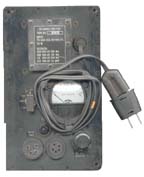




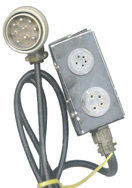
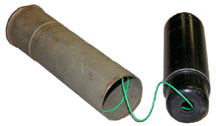

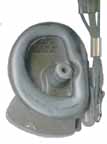
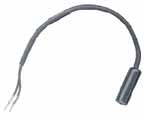

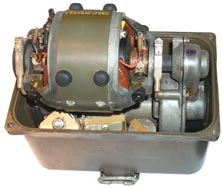
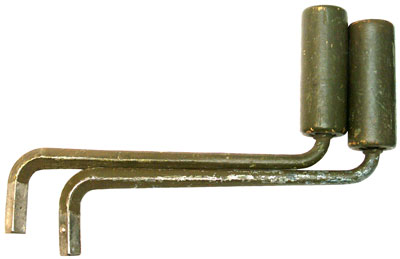
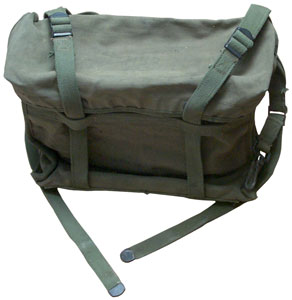
BG-175 or BG-402?
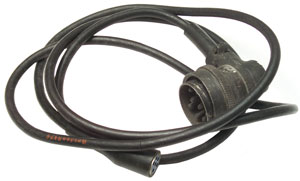
G-43 to PP-2684 Cable
Belden 8424 has 4 ea 20 awg
maybe 6 feet long
|
|
|
|
|
|
 |
 |
 |
 |
 |
 |
G-43 Set eBay photo |
 |
 |
|
|
|
|
G-43 Generator |
||
 |
  |
 |
 |
 |
| GN- |
 |
 BG-175 or BG-402? |
 G-43 to PP-2684 Cable Belden 8424 has 4 ea 20 awg maybe 6 feet long |
This is a radio set where each major component is built into a
waterproof cast metal housing. This would allow the set to
be stored under ground, under water and retrieved when
needed. Came into being after W.W.II and prior to 1969.
The GRA-71 Code Burst Keyer can
be used with this set after the T-784 has been modified to handle
the high speed Morse code. Note there is no provision to receive
high speed code in the field, only transmit. The idea is to
minimize the time an enemy has to locate the transmission by
minimizing the time to transmission. High speed transmission
is also too fast for a human enemy operator to copy, it requires
recording and playback at slower speed.
Used in Vietnam by forward observers with the GRA-71 burst
transmission device. In this application the radio operator
would only take with him the parts of the system to be used , not
the metal storage boxes and not all the parts. Would like to
know when? before or after 1969. In 1969 U.S. forces
discovered a NVA/VC communications listening post that proved the
NVA/VC could and were using COMINT against us on a scale that no
one imagined.
Note that this radio was not designed to be used while moving. It's for use in a fixed position.
The PRC-64 (aka CIA Delco 5300) may
also have been one of the radios that replaced the GRC-109.
I've read that the GRC-109 is based on the GRC-9. There is a resemblance, but not exact match.
| GRC-9 |
GRC-109 |
|
| Tx Modes |
CW-AM-MCW |
CW, HSCW |
| Rx Modes |
CW-AM-MCW | CW |
| Tx tubes |
3A4 3A4
2E22 0C3 3A4 |
6AC7 2E26 |
| Rx tubes |
1L4 1R5
1L4 1R5 1S5 3Q4 1R5 |
1T4 1L4
1T4 1T4 1T4 1U5 |
T-784/GRC-109 Transmitter (RT-3)
Two tube Crystal controlled 3 to 22 MHz with 10 to 15 Watts output. It's designed to be keyed from the front panel CW key manually or by plugging in the 300 word per minute GRA-71 high speed keyer. The signal would be received at a base station with a rack of equipment to record the message and then play it back at a slower speed.
The oscillator is a crystal controlled 6AC7.
The final tube is the 2E26 Beam Power Pentode. prf1ss338.pdf -
The USS Pampanito (SS-383) has a 2E26 tube somewhere on it and is origional for a late summer 1945 date.
Gonset 6-Meter Communicator of the 1950s used the 2E26.
Collins 310 also uses the 2E26 tube ad from Dec 1946
Millen 90810 VHF Transmitter of late 1940 vintage used the 2E26 as a driver multiplier.
R-1004/GRC-109 Receiver
Superhetrodyne, 3 to 24 MHz coverage in 3 bands. Note that the receiver is not capable of receiving 300 WPM code.
The receiver appeared to be DOA.
I checked the PP-2685 outputs and they were +1.6 and + 108 VDC right on the money.
Checked the filaments on all the tubes and they were all in the 7.5 to 10 Ohm range, OK.
Tried again and the receiver was receiving stations without an antenna when out of it's case.
See Hints & Tips for more about what goes wrong.
Put in back in and tuned around. Using a B&W 1.8 - 30 antenna and Trimm headphones.
Need to open it up again to lube the tuning mechanism. A shot of WD-40 after removing the Bat Off knob and the Tuning knob helped, but it still is tiring to turn these knobs. The WWV stations are right on frequency.
H-65/U headphones are marked 4,000 OhmsPP-2684/GRC-109 Power Supply
75 to 260 VAC at 40 to 400 cycles -or- 6 VDC -or- G-43/G generator. Outputs to power T-784, R-1004 and charge 6 V battery.PP-2685/GRC-109 Power Suply
75 to 260 VAC at 40 to 400 cycles. Outputs to power T-784, R-1004.CN-690 Voltage Regulator
"For use only when R-1004 is operated from G-43"
Uses an OB2 voltage regulator tube and replaces the large power supply.
The housing has two sockets, see closeup photo above, one for the receiver and one for the transmitter.
A PL-294 plug with 9 male pins mates to the GN-43.
G-43/G Generator (NSN: 6115-00-510-0611)
Used in the 1950 to 1990 time frame.
Manuals:
TM 11-5122
TM-11-6115-218-xx
G-77/G Generator (NSN 6115-01-072-8080)
Used up to 1990.
Manuals:
TM-11-6115-218-xx

Operation Accessories
Technical Manuals:
TM 11-5820-474-14 (ETM 018757.pdf, 36 MB)
Operator's Organizational, Direct Support, and General Support Maintenance ManualThe -14 manual on ETM has changes through 6 and includes testing procedures through fourth echelon.CN-690/GRC-109 Voltage Regulator
It also has "A" size schematics for each of the component parts shown above.
Earlier manuals were Operator, Organizational, and Field Support.
No. 18 wire, 100'
AS-1722/GRC-109 Antenna
CX-11042/GRC-109 electrical power cable assembly
CX-11041 Special Purpose cable assembly
MK-833/GRC-109 Maintenance KitMX-6792/GRC-109 Adapter, lamp holderTransit Case - photo from eBay
MX-6793/GRC-109 adapter, headset (from 1/4" mono phone socket to tip plugs)
CY-4621/GRC-109 case
clamp, electrical ground
connector, adapter (lamp base)
TL-29 knife
Pliers, ling-nosed
screwdriver
wrench, open end
wrench, Allen No 8
Running SparesOB2 tube
1L6 tube
1T4 tube
1U5WA tube
2E26 tube
6AC7 tube
3AG 2-amp fuse
3AG 15-amp fuse
white porcelain insulators (antenna egg style)
GE 47 lamp
6-volt vibrator
Generator Set, Gasoline Engine, 0.125-KW, 115-Volt, Single-Phase, 400-Cycle, Special-Purpose, Portable, with Carrying Case, Model UGP-12 MIL-G-52368A(1)
Date: Wed, 15 Feb 2006 10:16:51 -0800
From: "Kenneth G. Gordon"
Subject: Re: [Milsurplus] GRC-109, RS-1 transmitter - keying
On 15 Feb 2006 at 11:54, B. Smith wrote:
Has anyone modified the Transmit Receive (TR) circuit for the T-784(GRC-109 or RT-3 (RS-1) to improve receiver sensitivity when using the internal automatic antenna switch between transmit and receive?I have.
is keyed. The problem is that there are extreme loses in the receive side of the TR circuit due to the receiver coupling capacitor C14 which is only 18 pf but is in the output circuit of the transmitter.No. That isn't the problem: the problem is called "suck-out" and is caused by the transmitter's final tank circuit being tuned to the same frequency as the receiver's input circuitry. One of the list members on the Glowbugs list calculated the losses due to the final tank circuit being connected effectively in parallel or series (I have forgotten which) with the receiver's input circuitry, and it amounts to -30DB LOSS!!! in the case of the GRC-109.
The receiver sensitivity loss is paraphrased in TM-11-5820-474-14, Chapter two, 14e, under "Preliminary Connections, Separate Transmitting and Receiving Antennas."Yes, but it doesn't tell you why: it is "suck-out", period. The receiver coupling cap is plenty big enough to do the job.
In Vietnam at base camps the sets were used with separate antennas.Yes, and that method was suggested in the manual too. The internal TR switch was only to be used in an emergency.
I have been using an external antenna change over switch for the set to prevent the receive loses but I am preparing to modify the setThere are several ways you can do it: what I did was non-destructive. I mounted one of those small 5 VDC Radio Shack relays internally on a bit of double-sided tape, and used a single diode to rectify the filament voltage as a 1/2 wave rectifier. I oriented the diode in such a way that if you used 6 VDC on the filaments, the diode would pass that voltage on to the relay so the circuit works the same way whether you are using AC or DC.
using either pin diodes (ugh) or a small relay. :-)
| I've seen three of these over the years and
the one in my collection is marked (in felt pen) for SEAL
and SF use with GRC-103 radio (220 - 1850 MHz). I believe
this is incorrect and was actually intended for the
GRC-109. One example I've examined was a cutaway
that came from the manufacturer, AAI Corp., via a retired
engineer. The other was at the EOD unit at Camp Pendelton
about 20 years ago. So I know they existed but don't know how extensively they were used or if they are documented anywhere in the literature for the radios themselves. Are any of you spy radio enthusiasts familiar with this device? I'll take a couple photos and post them if anyone would like to see it. Thanks. Rick |
William L. Howard Technical Museum - Spy Radios of WWII - "With the end of the war, these sets seem to have disappeared. The OSS was disbanded and in 1947 it's successor, the Central Intelligence Agency was established. The first set adopted by the CIA was the RS 1 which bears no resemblance to the SSTR 5 or the SSTR 1. The RS 1 was adopted by the military, with some modifications and designated as the AN/GRC 109 . . ."
Modifying HC-6 crystals to have larger diameter pins like an FT-243 so they can be used in the T-784 transmitter, Done be soldering an octal tube pin onto the crystal wire lead.
FM 24-24 Chapt 4 -
GRC-109 by Peter McCollum
Antique Radios - Solid State Replacement for the 1L6 - eBay seller -
Preliminary Instruction Manual for Radio Set AS-3 February 11, 1959 -
Technical Notes on AT-3 Transmitter August 26, 1960 -
AT-3 Photo - poor quality B&W
Engineering/Operational Base Station Automatic Alarm - December 11, 1961 - use the 150 Hz IDY signal that's part of the tape preamble as a signal - maybe the beginning of the "New Squelch" on VHF low band radios like the PRC-25
The RT/A-3 Transmitter, a part of the BN-2
Test of the HRT-2 (Homing Radio Transmitter) with Various antenna Systems - also see Beacons -
Back to Brooke's Products for Sale, PRC68 Family Radios, Military Information, Crypto, GRA-71, Home page
Page created 27 July 2001